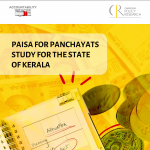
Citizens’ Participation in Urban Governance: A Dead End?
17 September 2020
This blog is part of a series that explores the conceptual underpinnings of decentralisation. The first part can be found here.
Over the last month, even as I gathered my thoughts to write about how decentralisation of the administration might can be best approached in India, I have been witness to yet another failure, at least a momentary one, in citizens being able to assert their will over those who govern. This is in Bengaluru city, which often shines, at least in PowerPoint presentations made in official conferences, as a city that is relatively better governed than most others in India.
Bengaluru is famous for its two large parks in the city. Lalbagh, in southern Bengaluru, was developed by Tipu Sultan in the 18th century and flourished during the reign of the British and the Mysore Maharaja. Cubbon Park, which has been renamed as the Chamarajendra Park, but nobody notices that, is more centrally located. It has been named for one of the Commissioners of the British who administered Bengaluru in the better part of the 19th century. A 300 acre sprawling extent, it has been steadily eroded by construction.
The western parts were taken over for building the government offices by the British; their erstwhile secretariat now houses the Karnataka High Court. Further west, the park was taken over to build the Vidhana Soudha, the seat of the Karnataka Government, in the 1950s. Since then, even though the occupation of the park has been curtailed, it has not stopped. A tennis club was granted a place in the park in the early seventies, and other buildings do exist within its precincts.
Every now and then, the powers that be cast covetous eyes on the Park. A few months back, in a suo moto order passed by a Judge of the High Court, it was decided that the court would extend its area by demolishing a heritage structure and build a skyscraper. That was fiercely resisted, and the idea seems to have been given up, at least for the time being.
During the first days of the COVID-19 pandemic, when a strict lockdown was imposed, the Park went back into a well-deserved slumber. In spite of its location in the heart of the city, the park is a haven for wildlife; birds and squirrels revel in its large trees. And in summer, there can be no better experience than napping on a bench in the park, listening to the shrill cadence of thousands of cicadas, a harbinger of rain in later months.
This year, the cicadas thrummed on undisturbed by the roar of traffic. The park revived, and how!
This is but another case study of a familiar, but depressing pattern in how citizens’ protests are increasingly brushed aside by the administration to get the latter’s way through.
A couple of days ago, curbing my better instincts, I threw physical distancing to the winds and went to the park. The transformation was remarkable. A half-year of being not thrown open to traffic was enough to revive the park. The grass seemed greener, the trees were no longer covered in traffic grime and the flowers were brighter.
However, in spite of protests from the public, the park was thrown open to vehicular traffic a couple of days back.
The fact that the government was contemplating the movement of traffic through the park had been in the air for some time. The City Corporation, which responded to the public mood, passed a unanimous resolution that the park ought not to be opened to vehicular traffic. The Horticulture Department of the state government, which owns and manages the park, was also opposed to the move to let in traffic. The Department of Urban Land Transport was opposed to it.
Yet, a few days back, ostensibly at the behest of the Traffic Police, the park was opened to the public. At least that was what the notification said; it did not mention that vehicular traffic ought to be allowed to ply. However, that was how the police interpreted the order. The gates were opened. A redoubtable lady, Priya Chetty Rajagopal, who had been leading the protests, was pushed aside. ‘Sorry, Madam’, the Constable had the grace to say, ‘this is an order from the government’.
As I write this blog, a number of citizens bodies have sprung into action. A Public Interest Litigation has been filed before the High Court. More protests are in the offing. Youngsters are writing up petitions to the government. Concerned citizens are writing everywhere. Celebrities are tweeting their protests.
So much for the factual position. However, as I step back and look at the entirety of the situation, this is but another case study of a familiar, but depressing pattern in how citizens’ protests are increasingly brushed aside by the administration to get the latter’s way through, whatever may be the circumstances.
It makes me think. Why does the government behave in this way? Is there a lesson here for those who believe that accountability systems work?
In the early 2000s, when I used to work in the Government, there was a period of hope and belief. The theory of change that brought in a large number of citizens organisations into the field of public participation, was that the government would be responsive to their appeals. It was an era of polite engagement. Government officers reached out, citizens bodies responded, everybody heard each other out quite politely. Citizens organisations took the dulcet words of bureaucrats trained in the art of politeness as watertight assurances that the right thing would be done.
But time and time again, nothing happened.
Where does one go from here? Whither, public participation, if the government won’t listen?
T.R. Raghunandan is an Advisor at Accountability Initiative.
Also Read from the Author: Whither, Local Governments, in the Pandemic?
Also Read: Youth Activism, the Climate Crisis and Civic Participation





